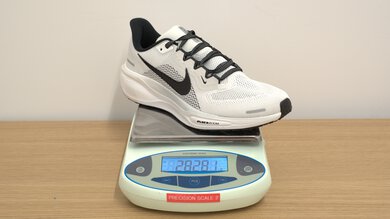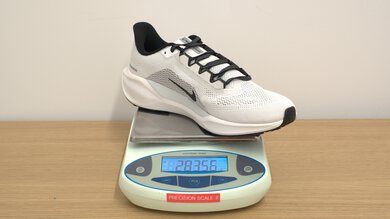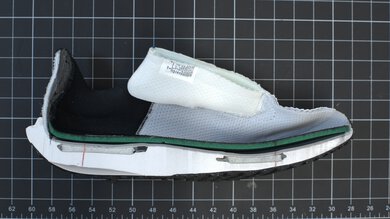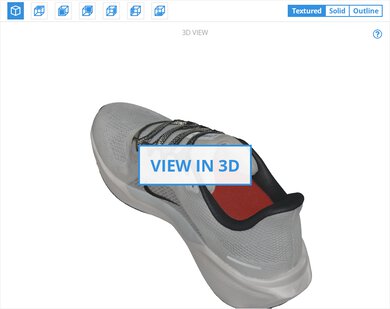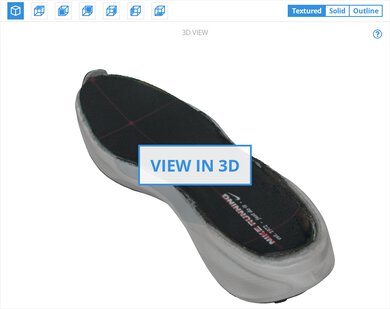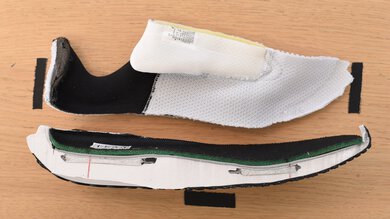The Nike Pegasus 41 is a classic daily trainer that aims to balance comfort, durability, and adaptability for easy runs. It features Nike's ReactX foam and Air Zoom units for a stable experience underfoot with a slightly rockered sole shape for smooth transitions. This shoe is a dependable option for runners of all experience levels seeking a solid, everyday running shoe.
Our Verdict
The Nike Pegasus 41 is a poor choice for marathon racing, mostly because of its limited cushioning and lack of energy return. These make it uncomfortable and inefficient for sustained long-distance efforts, relegating the shoe to shorter or more casual runs rather than competitive marathon events.
-
Very stable ride.
-
Heavy.
-
Midsole feels thin and harsh.
The Nike Pegasus 41 offers an adequate, though not ideal, experience for 5K and 10K runs. Its exceptionally firm forefoot helps in theory, but this is paired with disappointing energy return and heavy construction, which compromise its overall performance. It's usable for casual runners or training runs, but serious competitors should seek more specialized, lightweight racing options.
-
Firm forefoot foam.
-
Heavy.
The Nike Pegasus 41 provides sub-par energy return, particularly lacking in heel response, which affects runners who predominantly heel-strike. Although the forefoot performs slightly better, overall energy transfer is not strong enough to enhance propulsion significantly. This shoe feels uninspiring for runners looking to optimize performance or sustain higher intensities.
-
Not bouncy.
The Nike Pegasus 41's cushioning is noticeably poor, particularly at the forefoot. This is inadequate for runners who need significant protection or comfort, especially during longer or more intense runs. The heel cushioning is slightly better but still insufficient for sustained running, making the shoe a questionable choice for those prioritizing comfort.
-
Midsole feels thin and harsh.
The Nike Pegasus 41 has very good lateral stability, making it a great choice for runners who prioritize a secure, confident feel underfoot. Its midsole is very firm, which, combined with a moderate stack height, offers excellent support. Runners looking for reliable stability will find this shoe a trustworthy companion on varied running surfaces.
-
Wide heel base.
-
Foam is extra firm.
-
A bit narrower at the arch.
- 4.9 Marathon Racing
- 6.5 5K/10K Racing
Performance Usages
- 5.7 Energy Return
- 4.7 Cushioning
- 7.8 Lateral Stability
Changelog
- Updated Apr 02, 2025: Converted to Test Bench 0.8.
- Updated Apr 02, 2025: Review published.
Check Price
Differences Between Sizes And Variants
We tested the Nike Pegasus 41 in men's US size 9, as noted on the label. The color shown here is White/Pure Platinum/Summit. This model is available in a wide range of other colorways, including Ashen Slate/Armory, Summit White/Bright Crimson/Glacier, and Black/Anthracite/Black. The 'Nike By You' platform also allows you to create your own custom designs. Lastly, there's a waterproof GORE-TEX edition.
Wide versions are available for both men and women. There are also several special editions, such as the Electric, "Prequel," and Blueprint editions, along with sports team variants like the "NFL Dallas Cowboys," "Cincinnati Bengals," "North Carolina A&T," "Virginia," and "Michigan" editions. The design section applies only to the exact model we tested, but we expect other size and gender variants to perform similarly.
The "EasyOn" edition shares most features and materials, though its upper has a slightly different shape. Nike also sells the Nike Pegasus Trail and other lifestyle, throwback, and sneaker variants with the Pegasus name, though these aren't road running shoes, and our results don't apply to those models.
Compared To Other Running Shoes
Launched in 1982, the Nike Pegasus has evolved gradually through slow and steady iterations, cementing its legacy as a reliable, classic daily trainer. The Nike Pegasus 41 remains true to this heritage, offering a stable, consistent ride and strong overall value for everyday mileage. For most runners logging easy, uncomplicated miles, this shoe provides all the essentials without frills. However, the market offers numerous alternatives that deliver a significantly more cushioned and enjoyable ride, such as the ASICS NOVABLAST 5 or the moderately stacked, lightweight HOKA Mach 6.
Within Nike's lineup, the Pegasus 41 sits as a dependable, entry-level option, below more specialized, cushioned trainers such as the Nike Vomero 17 or the Nike Invincible 3 and premium racing shoes like the Nike Vaporfly 3 or the Nike Alphafly 3. Two trainers in the Pegasus lineup offer more features than the base model: the Nike Pegasus Plus with a ZoomX midsole and the Nike Pegasus Premium with dual-layer foam and Air Zoom.
While the Pegasus 41 continues to serve as a dependable workhorse, runners seeking greater cushioning or a more luxurious underfoot feel might find these alternatives better suited to their needs.
For more options, check out our recommendations for the best running shoes.
The Nike Vomero 17 is like a more premium, built-up Nike Pegasus 41. With more responsive ZoomX foam in its midsole, the Vomero provides a bit more energy return and feels noticeably more cushioned, giving it a softer, plusher feel that makes it a better option for easier paces and longer runs.
The Nike Pegasus 41 and the Nike Invincible 3 are both daily trainers, but they cater to different preferences. The Pegasus 41 offers a firmer, more grounded ride with better stability, making it a more traditional daily trainer. It's also marginally lighter. In contrast, the Invincible 3 is more cushioned, bouncier, and more versatile, thanks to its plush ZoomX foam, which makes it a better option for most.
The adidas Supernova Rise and the Nike Pegasus 41 are similar trainers overall. Neither is especially lightweight or high-stack, and they offer similar levels of cushioning. The adidas is a bit more efficient, with a more responsive PEBA-incorporated foam.
The Saucony Triumph 22 and Nike Pegasus 41 share a similar level of stability, but their ride experience is distinct. The Nike has a more traditional design, with a lower stack height and a firmer feel. The Saucony provides a softer, more cushioned ride, appealing to runners who prioritize plush comfort during their runs.
The Altra Torin 7 and the Nike Pegasus 41 are both daily trainers offering comparable levels of stability. The Torin 7 features a zero-drop design and some cushioning, appealing to those who prefer a more grounded feel and a wider toe box. However, its cushioning, while present, may not provide the plushness some runners desire. In contrast, the Pegasus 41 maintains a traditional higher heel-to-toe drop, which can benefit heel strikers looking for a smooth transition. Also, the Nike has a slightly more energetic ride. This makes the Nike a suitable option for runners who prefer to avoid max-cushioned models but still desire a higher heel-to-toe drop.
Test Results
The Nike Pegasus 41 has average weight for a daily trainer, but many comparable models, like the Brooks Hyperion 2, feel noticeably lighter underfoot. That said, for typical daily training, this extra weight won't significantly hinder performance.
The heel energy return is sub-par, providing minimal bounce or responsiveness upon impact. This shoe feels somewhat dull for heel strikers seeking a lively or energetic ride, limiting its appeal to runners looking for snappier performance during tempo runs or interval training.
Although it slightly outperforms its heel counterpart, the forefoot energy return still falls short of delivering meaningful bounce, which could leave forefoot runners wanting more dynamic feedback from their strides.
Heel cushioning is mediocre overall, though slightly better at absorbing high-impact forces compared to moderate strikes. Heel strikers will experience adequate comfort on stronger impacts, but overall cushioning might feel insufficiently plush or protective during longer runs, particularly if they prefer a softer ride.
The forefoot cushioning is bad; it feels thin and minimally protective. Mid and forefoot strikers seeking a plush, comfortable landing will find this shoe too harsh or unforgiving, particularly over extended runs or faster-paced sessions, since the foam will bottom out underfoot.
The Nike Pegasus 41 is very firm at the heel, consistently providing stable and secure support. Runners who prioritize stability and predictability will appreciate this feature, but some alternatives, like the Nike Vomero 17, are softer and less harsh.
The Nike Pegasus 41's forefoot is exceptionally firm, offering great support throughout the forefoot area regardless of impact intensity. That said, it will feel excessively rigid for those desiring greater softness.
Check Price
Comments
Nike Pegasus 41: Main Discussion
Let us know why you want us to review the product here, or encourage others to vote for this product.


